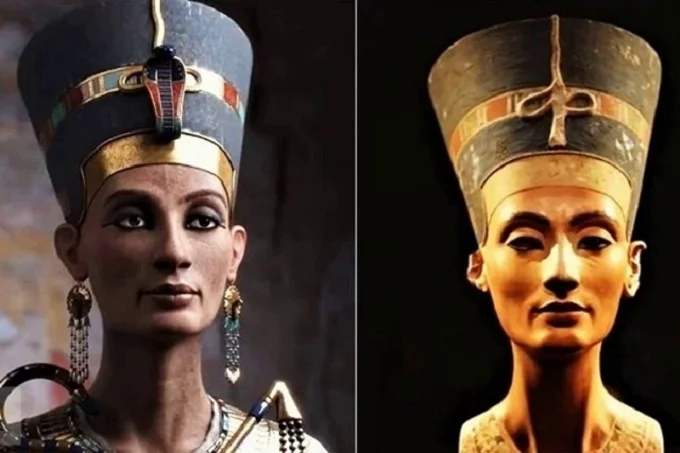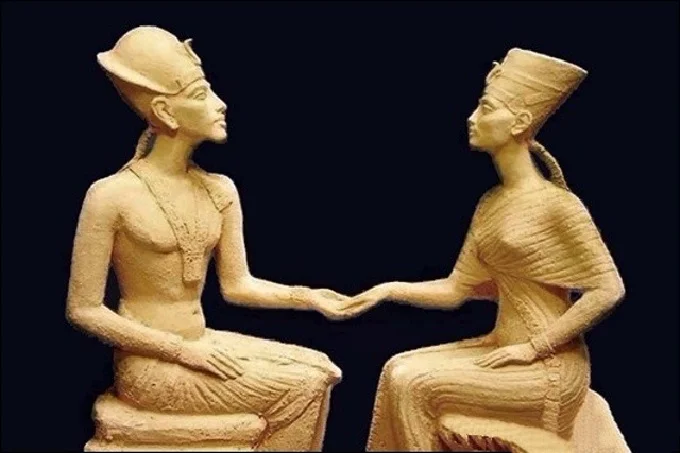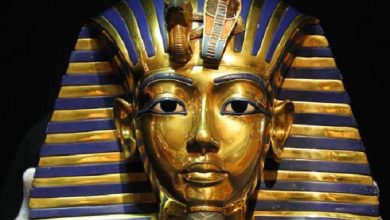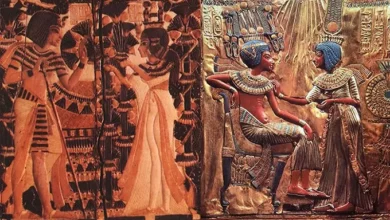The mystery of Nefertiti

Everyone has most likely seen the gorgeous profile of Nefertiti, but the facts on this beauty’s identity are so contradictory that it is quite challenging to offer a whole image; still, let’s attempt…
The “right hand” of Pharaoh
At the close of the fifteenth century BC, the caste of Egyptian priests controlled a vast amount of riches. They were also the most educated segment of the population, as shown by the fact that they were able to forecast the flooding of the Nile, create maps of the starry sky and calendar, and understand how to compute the surface area of geometric objects. As they gained confidence in their position, the priests started making their demands known to the royal authorities.
An open fight broke out about the same time, during the turn of the 15th and 16th centuries BC. Pharaoh Amenhotep IV is credited with establishing the religion of Aton, the one deity believed to be the embodiment of the sun. The previous places of worship were destroyed, and their property was taken away. The monarch relocated his capital from the ancient city of Thebes to a new city that he named Akhetaton (which means “horizon of Aton”), and he also adopted a new name for himself. Akhenaten (“useful to Aton”).
In the spring of 1965, an American amateur archaeologist by the name of Ray Winfield Smith, who had previously worked as a diplomat, discovered approximately 16,000 fragments of limestone with fragments of inscriptions, images of hands and heads, the solar disk, and rays emanating from it on the land that was once the site of ancient Thebes in Karnak. Smith commissioned photographers to take photographs of each piece, and then he traveled to museums located in a variety of towns and countries to look for and photograph more shards of similar provenance. As a direct consequence of this, around 40,000 photographs were produced. The use of computer analysis made it possible to choose from among them those that could be pieced together like a jigsaw – specifically, a puzzle designed for youngsters.
It was easy to grasp the function that the lovely Nefertiti (“beauty is coming”) played in the founding of the worship of Aton after the pictures and inscriptions were largely reconstructed. Nefertiti is credited with introducing the cult.
After doing research on the materials that were gathered by Smith, the historian from Munich, Philip Vandenberg, discovered that the name and pictures of Nefertiti are far more prevalent on the walls of the temple than those of Akhenaten. The investigation led the researcher to the conclusion that the eccentric Pharaoh’s realm was really ruled by the woman in question.
Different accounts of how things got started and how the “career” got underway
The information that may be found in a variety of sources on the background of Nefertiti is quite contradictory. There are now many different versions available.
According to a theory that is among the most prevalent, Nefertiti? The daughter of the king of Mitanni, a kingdom located in Upper Mesopotamia, which was at the time one of Egypt’s most important allies.
According to one of the alternative narratives, she is the daughter of a nobleman who served in the royal court. Another possibility is that she was the daughter of Aye, who was the brother of Teye, who was the wife of Pharaoh Amenhotep III, who was Akhenaten’s father. It was later discovered that Nefertiti was Teye’s niece as well as the cousin of her husband’s family. According to another version of the mythology, Nefertiti may have been Amenhotep III’s daughter, but by one of his other wives.
To what has been mentioned, there is only one thing left to contribute, and that is such an event from the life of a young “novice” queen that seems to be nearly unbelievable.
According to legend, she was married off to the elderly Pharaoh Amenhotep III when she was just fifteen years old. Nefertiti became the bride of Amenhotep IV, who was just 12 years old at the time of his father’s death, two years after the old king passed away. Amenhotep IV’s mother, Teye, was a powerful figure in court.
By the way, she, along with Nefertiti (according to one story), hailed from the royal family of Mitanni, where it was normal for queens to assist in the government of the state. Nefertiti was also said to have been a member of the royal family.
According to the traditional definition, what is incest?
Archaeologists discovered a depiction of Akhenaten, Teye, and Teye’s daughter Princess Bekataton on one of the bas–reliefs. Princess Bekataton’s father could not have been Teye’s royal spouse Amenhotep III since he had passed away four years before the girl’s birth. There is a good chance that Akhenaten, the son of Teye, was Bekataton’s biological father.
According to the hypotheses of the American psychologist Immanuel Velikovsky, the incestuous connection in question might have been the factual inspiration for the Greek story of King Oedipus and his “Oedipus complex.” According to Vandenberg, a peculiar “love triangle” did not prevent Nefertiti from exerting political and religious dominance over the kingdom, and it was she who played a significant part in creating the religion of the god Aton. Nefertiti was the ruler of the state throughout this time. In addition, the fact that Nefertiti was victorious in the battle against the omnipotent priests of the deities worshipped in ancient Egypt is evidence of her immense political power.
Family life and concerns of the state
It is clear from the many pictures adorning the walls that the young couple had a prosperous and joyful family life. Their three daughters, all of whom were born within the first three years of their marriage, are always shown with both of their parents present. Together, Nefertiti and Akhenaten were responsible for the birth of six daughters.
In the fourth year of their existence together, Amenhotep IV starts the process of constructing a new capital city in the region of Middle Egypt that is now occupied by the town of Tel el-Amarna. Since the beginning of this project three years ago, magnificent temples, mansions, and graves have been built, alleyways have been covered with stone slabs, and trees have been planted. As soon as the construction of the Akhetaton was finished in 1357 BC, it evolved into the most magnificent structure that existed in the ancient world at the time.
In the thirteenth year of his reign, Akhenaten makes a surprising announcement and names Semnekhkar as his co-ruler. Semnekhkar was the spouse of Akhenaten’s oldest daughter, Meritaton. After then, Nefertiti’s star in the political sky begins to decrease in prominence. Exists any basis for making the assumption that Semnekhkara? Not only did he compete with her for power, but he also tried to steal Akhenaten’s affection away from her.
Something from the private part of my life
It would seem that throughout the latter years of the queen’s married life, she was the subject of much adoration from a large number of people. During these years, while still residing in her palace, she gave birth to three further children; however, each of these girls had a different father.
However, Nefertiti was not always nice to those who desired an intimate relationship with her. In 1971, three clay tablets were discovered, each of which seemed to be an image from a hand-drawn comic book. These tablets were discovered in Egypt. They describe how the master of ceremonies, Umihanko approaches Nefertiti with the intention of hugging her and how, on the direction of the enraged queen, he is tethered to a wagon filled with stones and sent out into the dry desert, where he dies ten days later.
It’s possible that she turned down other admirers in addition to one would-be suitor. The well-known bust of Nefertiti, which was sculpted by Thutmes and was commissioned by the court, was discovered in the location of the ruins of Akhetaton. The sculpture shows the queen with just one eye. On the other hand, the bust does not, in general, create the sense that it is incomplete. Vandenberg is of the opinion that the absence of the left eye is an expression of the artist’s hopeless desire for vengeance against a capricious beauty that did not return his feelings. He believes this because the artist was consumed with passion for beauty, but she did not reciprocate his feelings.
Despite her popularity with men, Nefertiti did not marry again after her first husband. However, she chose to wed Pharaoh Tutankhaton, who was just 11 years old at the time, to one of her younger daughters, Ankhesenpaaton. Soon after, the new emperor departs from Akhetaton, travels back to Thebes with his court, revives the worship of the ancient gods, adopts a new name — Tutankhamun? — and passes away around 1349 BC, when he was about 20 years old.
And after almost 3,300 years, Howard Carter, an archaeologist, discovers the tomb of this young king, in which, in addition to his corpse, there are valuable pieces of art that are now renowned all over the world as the “treasures of Tutankhamun’s tomb.”
According to the account that is generally accepted, Nefertiti passed away when she was 34 years old, most likely as a result of the plague pandemic. Her grave site has never been discovered to this day. If she is ever found, researchers will surely get fresh knowledge on both the life and death of this very enigmatic woman.

Another audacious guess…
In the meanwhile, a highly creative theory has been developed to account for what happened to Nefertiti during the latter years of her life. Nicholas Reeves, a researcher, believes that the disappearance of Nefertiti at the end of Akhenaten’s reign can almost certainly be considered to be her promotion as a co-ruler and heiress of the Pharaoh but under a different name. Reeves makes this argument in his article “The Disappearance of Nefertiti at the End of Akhenaten’s Reign.”
In this particular instance, Reeves is certain that she is the enigmatic Pharaoh Semnekhkar, who succeeded Akhenaten and was the forerunner of Tutankhamun. Her caresses and ardent display of feelings for the heretic Pharaoh Akhenaten, which were captured in paired images of the era of their joint rule, caused extreme amazement among Egyptologists. In fact, there was even an assumption about an unconventional sexual orientation of both. The odd asexual colossi created by Akhenaten are, as a result, sculptural representations of Nefertiti posing as a pharaoh while seated on a throne.
…and a theory that is just as audacious
It is well knowing that a widespread outbreak of sickness ravaged Egypt before the passing of Akhenaten, which resulted in the deaths of a great number of people. The former priests of the “retired” gods said that these were the genuine gods, which the heretic pharaoh had rejected, and as a result, the land was subjected to a severe type of punishment. The majority of Egyptians took the aforementioned claims seriously. There was a potential for conflict.
In such a predicament, Nefertiti’s oldest daughter Meritaton and her new husband (Semenkhara had passed away), at the head of a huge detachment of their supporters, departed the kingdom on many ships. They were followed by their devoted followers.
After making a lengthy journey through the southern and western shores of the Mediterranean Sea, including lengthy stays on land (traces of which are uncovered by archaeologists), the armada eventually entered the Atlantic Ocean and began sailing north along the coast.
In the historical records of a number of different peoples and cultures, Meritaton is referred to as Scott, and Gayutelos is referred to as her husband. All of this information can be readily tracked.
In the end, the crew decided to call the territory that is now Scotland home. Relations with the indigenous people were largely calm; nevertheless, on occasion, tensions rose, and skirmishes broke out, which sometimes turned into full-scale warfare. Scott was killed in action during one of these conflicts. And its warriors, who eventually mingled with the indigenous people and formed an integral part of the population of the nation, which was later dubbed “the land of the Scots,” Scotland – Scotland, became an integral part of the population of the country.



